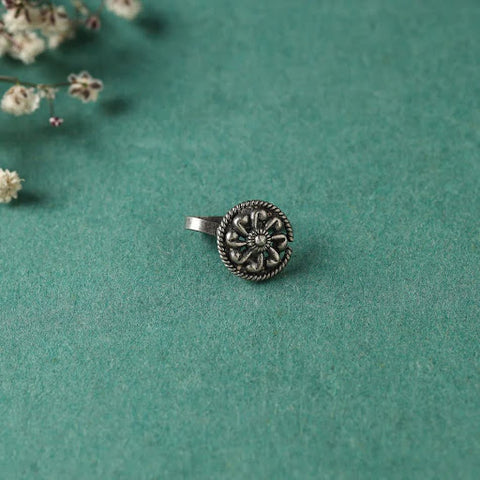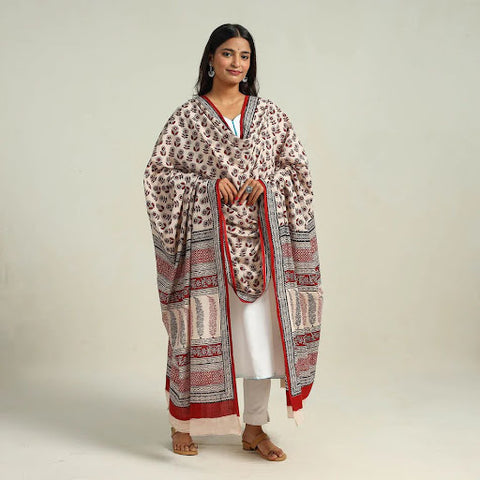The geometrical and paisley prints of Bagh, that once dressed tribes across the Malwa plateau and beyond, are under threat from industrialisation and technology.

Ismail Sulemanji Khatri’s family started Bagh printing in the small village of Bagh, Madhya Pradesh, which lies somewhat 150 kms away from Indore. Photo by: Vamika Singh
The art of Bagh printing was originated by Muslims from the Khatri community, whose familial legacy goes back to Pakistan’s Sindh Province. Long before the handicraft got its name after the Bagh River in Madhya Pradesh, the Khatris relocated several times in order to find a suitable place for their business, which required being in vicinity of a natural water source. Lying around 150 kilometres away from Indore, the town became an abode for these artisans not only due to its proximity to the village’s river but, also because the unique chemical composition found in the water enhanced the texture of natural dyes used in making Bagh prints.
Ismail Khatri, the creator of this skill, redefined block printing when most tribal craftsmen gradually discontinued handiwork, as the synthetic industry grew in the 1960s. He stuck to his inherited family metier and trained his son, Abdul Kadar Khatri, in the craft. Abdul, a National Awardee for his outstanding contribution towards block printing, is survived by his wife, Rashida Bee Khatri, and four sons, Arif, Mohammed, Hamid Zilani, and Mohammed Ali. Now in the age of social media and fast fashion, the family finds it difficult to compete with clothing industries that specialise in bulk manufacturing and inexpensive rates.

Rashida Bee Khatri, the family’s de-facto head is a sought-after, award-winning artisan, actively training women in the region in the method of block printing to lead an independent life. Photo by: Vamika Singh

Right before the cloth is ready for printing, it is dipped into a solution of Harda (terminalia chebula) powder and later is dried in the sun. The process, known as peela locally, is indicative of the sheer manual labour that goes into creating each distinctive piece. Photo by: Vamika Singh

Tribals make up the majority of the population in Madhya Pradesh’s Dhar district, under which Bagh village falls. Since the beginning, members of these tribes have accounted for more than 80% of the workforce behind Bagh printing. For years, the Khatris have tirelessly taught the practice to other communities to spread awareness about the importance of preserving this legacy. Photo by: Vamika Singh

These blocks are as old as 300 years. Collected by Ismail and Abdul Kadar Khatri, these blocks depict traditional motifs, inspired by cave paintings in the region, and Mughal karigari. The prints have the biggest market in Bhopal with sales being nearly 60%-70% of the stock, followed by Delhi, Kolkata and Chennai. Photo by: Vamika Singh

The cloth is stretched out across a printing table by a skilled artisan, wooden blocks are then gently placed in congruent angles on the fabric after being dipped into natural dyes made of tamarind seed flour and fermented iron rust solution. Bagh remains the only site where tourists can experience this craftsmanship hands-on. Photo by: Vamika Singh

As printed fabric requires repeated rinsing for removal of excess dye, standing for long hours in water is inevitable for the workers, and it can be harsh. Hamid Zilani stated that the components of rinsing and drying can be modernised with the help of washing machines and automated dryers. This change will also speed up the process during monsoons, which is otherwise not a profitable season for business. Photo by: Vamika Singh

While sustainable options in fashion are often overlooked for being costly, even the hands that are overworked to achieve exclusivity go unnoticed. Electric machinery may cut down processing time but it also cuts short the chances of being employed, especially with limited profits and wage margins in the handicraft sector. Photo by: Vamika Singh

The bhatti, a copper cauldron where the final printed cloth is boiled for a few hours at 100 degrees Celsius for colour-fixing. Reflected in the water are the madder leaves used in making the natural dye (alizarin). During my interaction with the Khatri family, I learned that in order to value the difficulty that weighs into the entire process of making the prints, the buyer first needs to understand the mastery behind it. Unfortunately, with changing times, word of mouth has stopped being considered credible as opposed to a promotion on social media. The family stressed that virtual publicity continues to be the sole blocker in terms of sales. Yet, if done right, it will be a boon to revive a diminishing art form. Photo by: Vamika Singh
This content is originally posted at National Geographic Traveller.
Blogs you might also like:
Pedna Kalamkari - In Conversation with Pitchuka Srinivas
Kahani' of The 'Khandani' Banarsi Wooden Artery
Magnificent Pattachitra Paintings of Orissa
 Verified Purchase
Verified Purchase






























Leave a comment (all fields required)